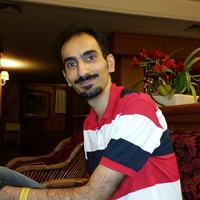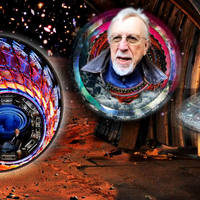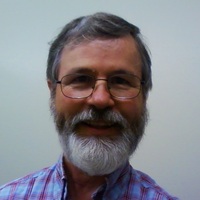Drafts by Daniela Angulo
We consider a three-level atom in a Λ configuration resonantly interacting with two field modes b... more We consider a three-level atom in a Λ configuration resonantly interacting with two field modes both initially in thermal states. We present the analytical procedure to find the entropy of the atom and the field with the atom starting in a pure state. Using a numerical simulation, we explore the entropy exchange of the atom and the field looking for the initial state of the atom in which both entropies are completely anticorrelated and assess the change in time of the atom populations for this case. We preliminarily study how entropy gets affected by a field mode in a thermal field when the other mode is in a coherent state.
Resumen Se estudiaron diversos aspectos relacionados con la evolución temporal de un paquete de o... more Resumen Se estudiaron diversos aspectos relacionados con la evolución temporal de un paquete de onda gaussiano; relación entre el ancho del paquete y el tiempo y coeficientes de transmisión y reflexión para los potenciales de barrera y pozo. Las situaciones a ser estudiadas fueron simuladas de manera computacional usando la versión del método numérico de Cranck-Nicholson desarrollada por Goldberg, Schey y Schwartz. Se encontró que los datos arrojados por la simulación que relacionan el ancho del paquete con el tiempo se ajustan a la relación matemática teórica que describe este comportamiento con un error estándar del 0.009826 %, al mismo tiempo los coeficientes R y T describieron conductas puramente cuánticas induciendo posibles relaciones funcionales para el caso del pozo y la barrera. Palabras clave: Paquete de onda, evolución temporal, unitario, ecuación de Schrödinger
Thesis Chapters by Daniela Angulo

During this year I was committed to achieve four tasks. The first was to become familiarized with... more During this year I was committed to achieve four tasks. The first was to become familiarized with the apparatus and be able to run the full experiment independently; Josiah taught me how to set the Magneto-Optical Trap (MOT) and take spectroscopy measurements. The second was to be of assistance in our experiment to observe a cross-Kerr nonlinearity based on weak Rydberg-Rydberg interactions; I would turn on the equipment, monitor the powers of the signal and probe beams and set our phase measurement system (spectrum analyzer) to take data. The third goal of my research work was to perform a cross-phase modulation experiment using N-scheme; I had to rebuild an optical setup "LMI table" that prepares all the beams which will interact with the atoms trapped in the MOT. Despite the fact that I did not reach the ultimate objective of measuring a phase shift, I performed spectroscopy measurements for the probe beam demodulating a beat-note created with two probe components (on-resonance and off-resonance) and by direct measurement of the on-resonance beam. Finally, my last task was to characterize a new phase measurement system, combining an analog IQ demodulator and a digitizer, intended to considerably increase our data collection efficiency in comparison with the spectrum analyzer used for the previous experiments.
Papers by Daniela Angulo

arXiv (Cornell University), Sep 29, 2023
When a single photon traverses a cloud of 2-level atoms, the average time it spends as an atomic ... more When a single photon traverses a cloud of 2-level atoms, the average time it spends as an atomic excitation-as measured by weakly probing the atoms-can be shown to be the spontaneous lifetime of the atoms multiplied by the probability of the photon being scattered into a side mode. A tempting inference from this is that an average scattered photon spends one spontaneous lifetime as an atomic excitation, while photons that are transmitted spend zero time as atomic excitations. However, recent experimental work by some of us [PRX Quantum 3, 010314 (2022)] refutes this intuition. We examine this problem using the weak-value formalism and show that the time a transmitted photon spends as an atomic excitation is equal to the group delay, which can take on positive or negative values. We also determine the corresponding time for scattered photons and find that it is equal to the time delay of the scattered photon pulse, which consists of a group delay and a time delay associated with elastic scattering, known as the Wigner time delay. This work provides new insight into the complex and surprising histories of photons travelling through absorptive media.

PRX quantum, Jan 26, 2022
When a resonant photon traverses a sample of absorbing atoms, how much time do atoms spend in the... more When a resonant photon traverses a sample of absorbing atoms, how much time do atoms spend in the excited state? Does the answer depend on whether the photon is ultimately absorbed or transmitted? In particular, if it is not absorbed, does it cause atoms to spend any time in the excited state and if so, how much? To answer these questions, we perform an experiment with ultracold rubidium atoms in which we simultaneously record whether atoms are excited by incident ("signal") photons and whether those photons are transmitted. We measure the time spent by atoms in the excited state by using a separate off-resonant "probe" laser to monitor the index of refraction of the sample-that is, we measure the nonlinear phase shift written by a signal pulse on this probe beam-and use direct detection to isolate the effect of single transmitted photons. For short pulses (10 ns, to be compared to the 26-ns atomic lifetime) and an optically thick medium (peak optical depth equals 4, leading to 60% absorption given our broad bandwidth), we find that the average time atoms spend in the excited state due to one transmitted photon is not zero but, rather, (77 ± 16)% of the time the average incident photon causes them to spend in the excited state. We attribute this observation of "excitation without loss" to coherent forward emission, which can arise when the instantaneous Rabi frequency (pulse envelope) picks up a 180 • phase flip-this happens naturally when a broadband pulse propagates through an optically thick medium with frequency-dependent absorption. These results unambiguously reveal for the first time the complex history of photons as they propagate through an absorbing medium and illustrate the power of utilizing postselection to experimentally investigate the past behavior of observed quantum systems.

Optics Communications, 2017
The determination of the density matrix of an ensemble of identically prepared quantum systems by... more The determination of the density matrix of an ensemble of identically prepared quantum systems by performing a series of measurements, known as quantum tomography, is minimal when the number of outcomes is minimal. The most accurate minimal quantum tomography of qubits, sometimes called a tetrahedron measurement, corresponds to projections over four states which can be represented on the Bloch sphere as the vertices of a regular tetrahedron. We investigate whether it is possible to implement the tetrahedron measurement of double slit qubits of light, using measurements performed on a single plane. Assuming Gaussian slits and free propagation, we demonstrate that a judicious choice of the detection plane and the double slit geometry allows the implementation of a tetrahedron measurement. Finally, we consider possible sets of values which could be used in actual experiments.
APS Division of Atomic, Molecular and Optical Physics Meeting Abstracts, 2020
Bulletin of the American Physical Society, Jun 3, 2020









Uploads
Drafts by Daniela Angulo
Thesis Chapters by Daniela Angulo
Papers by Daniela Angulo